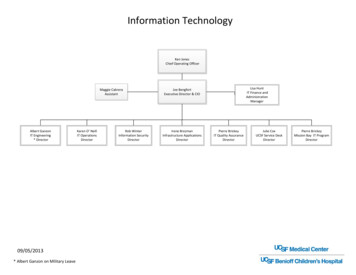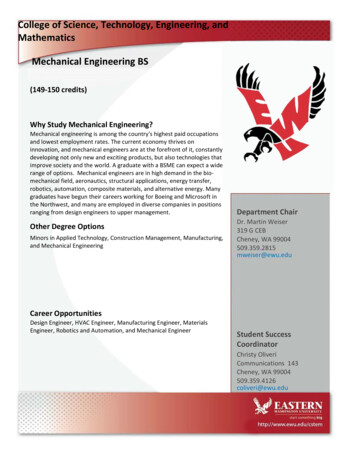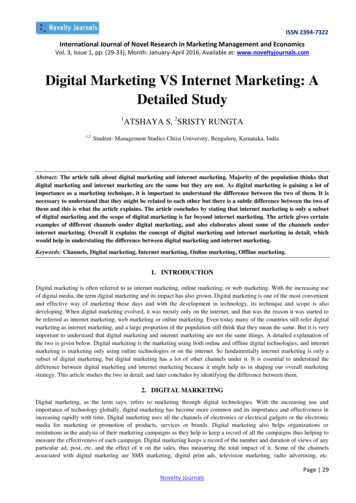
Transcription
Chris BlackwoodTechnical Marketing EngineerThis article is the seventh installment of Back to Basics, a series ofarticles that discuss the fundamentals of popular NetApp technologies.An important reason why IT teams choose NetApp storage is because itprovides the ability to use integrated data protection technologies likeSnapshot copies, SnapMirror replication, and SnapVault disk-to-disk backup. These capabilities dramatically accelerate andsimplify backup and replication for DR and other purposes.Still, we saw a need for deeper integration with backup applications,especially for those who need to include tape in their backupenvironments.NetApp introduced its SnapProtect management software about ayear ago to provide these and other features. NetApp partnered withCommVault to integrate core components of CommVault Simpana with core NetApp technologies. The combination delivers all the benefitsyou expect from Snapshot copies, SnapMirror, and SnapVault, plus itoffers significant advantages including:Accelerates both backup and restore operationsFull tape supportCataloging of Snapshot copies, replicas, and tapeBuilt-in support for VMware , Hyper-V , and popularapplicationsAutomated provisioning of secondary storageCascading and fan-out configurationsFlexible scheduling and retentionReportingSimple single-pane-of-glass management for all featuresThis chapter of Back to Basics explores how NetApp SnapProtect isimplemented, common use cases, best practices for implementingSnapProtect, and more.How SnapProtect Is ImplementedSnapProtect uses a variety of components. Most of these are familiarNetApp technologies such as:Snapshot copiesMore Back to BasicsLearn the fundamentals of NetApp coretechnologies by reading other chapters inthis hapter1:2:3:4:5:6:7:Thin ProvisioningDeduplicationFlexCloneVolume SnapMirrorRAID-DPData CompressionSnapProtectNetApp Data Protection Technology:Partner IntegrationIn addition to working with CommVaulton SnapProtect, NetApp works withseveral additional backup partners tomake advanced NetApp data protectionfeatures accessible from their products:Symantec NetBackup ReplicationDirector—Integrates NetAppSnapshot and replicationtechnologies into the Symantec NetBackup framework.NetApp Syncsort IntegratedBackup—Leverages NetAppSnapVault block-incrementalreplication to offer D2D andD2D2T backup for heterogeneous(non NetApp) data.
SnapMirror replicationSnapVault for disk-to-disk backupFlexClone technology for cloning and indexingSnapRestore technology for rapid restore of whole volumes and single filesOnCommand software (formerly NetApp Operations Manager) for provisioning and replicationIn addition, SnapProtect adds several additional components that enable cataloging, coordination, management, andso on.SnapProtect Server. Runs Windows , Microsoft SQL Server , and management softwareMediaAgents. Additional servers that help spread the data protection workload during SnapProtect operationsiDataAgents (iDAs). Software agents installed on backup clients that are responsible for data consistencyduring backup operationsFigure 1) Overview of SnapProtect operations.Most SnapProtect operations begin with the creation of a Snapshot copy on primary storage. This happens veryquickly and provides the first level of data protection. Each Snapshot copy is initiated by SnapProtect according toestablished schedules. Once a Snapshot copy completes it is indexed in the SnapProtect database.Next, if a SnapVault or SnapMirror activity is going to occur, SnapProtect passes control to the NetApp OnCommandserver to provision necessary secondary storage using the Resource Pools and provisioning policies assigned toSnapProtect. OnCommand then builds datasets, provisions necessary volumes, and starts baseline transfers fromprimary to secondary.If a tape copy is needed, SnapProtect provides three options, two of which can also be indexed in the SnapProtectcatalog. (See Table 1.)Table 1) Tape options.OptioniDataAgentIndexed?NDMP dumpNetApp NAS NDMPiDAYesSMTape (SnapMirror to Tape)NetApp NAS NDMPiDANoStreaming through media agentAll other iDAsYesNotesData ONTAP 8.0.1 software and laterSnapProtect support for various data typesThe specifics of SnapProtect operation vary slightly depending on the type of data being protected.
NAS data. When a Snapshot copy is made of NAS data, SnapProtect simply indexes the contents of the Snapshotcopy directly using the SnapDiff API, which returns a list of files that have changed (been created, modified, ordeleted) since the last Snapshot copy was made.For NAS data you can restore directories, files, and qtrees as needed, or you can revert an entire volume usingSnapRestore. If a file to be restored is available in a Snapshot copy on primary storage, Single File SnapRestore(SFSR) is used; a copy-back operation is used for restores from secondary storage.LUN data. Performing a SnapProtect operation on LUN data requires an iDA on the host accessing the LUN. This isbecause the host understands the format of the data being written. For example, the Windows File System iDAunderstands NTFS.The file system is quiesced (using Volume Shadow Copy Service on Windows hosts) before the Snapshot copy ismade. LUN clones are created and used for indexing the contents inside the LUN.Application data. Each application has its own iDA on the application host. The iDA prepares the database forbackup prior to the creation of a NetApp Snapshot copy. Restore options vary depending on the application beingprotected. Supported applications are shown in Table 2. Note that the backup and restore of application data bySnapProtect does NOT use NetApp SnapManager products.Table 2) Supported applications.ApplicationSupportMicrosoft ExchangeWindowsMicrosoft SQL ServerWindowsMicrosoft SharePoint WindowsDB2UNIX and Linux Oracle (including RAC) UNIX and LinuxSAP on OracleUNIX and LinuxVirtual machine data. A key feature of SnapProtect is the ability to protect many virtual machines quickly without theneed to install an agent in each virtual machine. In addition, SnapProtect can index the contents of each VM withdifferent levels of recoverability, including single file recovery. You can learn more about the advantages ofSnapProtect in virtual environments in a recent NetApp white paper.SnapProtect software uses a virtual server agent (VSA), which runs on a media agent designated to protect thevirtual environment, to perform data protection operations for virtual environments. Within the VSA, instances arecreated that define the type of virtualization solution being used.Discovery rules can be established so that new virtual machines are automatically added and protected. Forexample, using a discovery rule of “Datastore Affinity” automatically protects new virtual machines on specificdatastores.Use CasesOf the various possible use cases, NAS, virtual environments, and application backup and restore are probably theideal uses for SnapProtect. The tool not only gives you full cataloging, but you also get a simple interface forrecoveries with wild-card search capabilities that let you identify and restore necessary files in less time. Becausetape management and replication are all integrated, you can manage most of your data protection needs from asingle pane of glass.
VMware. For VMware backup and restore, SnapProtect communicates with vSphere via the VSA, andVMware-level snapshots are created before NetApp Snapshot copies. Single file recovery and live-browse aresupported for Windows VMs, allowing individual files from within a VM to be restored. Single File SnapRestore(SFSR) can be used for VMDKs stored in NFS datastores to accelerate the restore of an entire virtual machine.Application backups using an application agent (iDA) as described in the previous section can be performed, but onlyfor applications not installed on VMDKs. Exchange and SQL Server can be quiesced via the VMware VSA when theyare installed in VMDKs, providing consistent backup.Hyper-V. VSS is required to back up an online Windows VM. (Windows 2000 must be offline.) Single file restore issupported for Windows and Linux VMs.Cascade and Fan-OutIn addition to its ability to protect particular types of data, another important SnapProtect use case is support forcascade and fan-out configurations that let you more easily achieve your data protection, disaster recovery, andcompliance objectives.These configuration options allow you to fully automate the creation of backup copies and/or mirrors as required. Forexample, you can mirror to a remote site and then vault at that location (or to a third location) to provide the backuphistory you need. You can also vault locally and then mirror the vault to a remote location, giving you full local andremote copies of your important backups. The options are almost endless. You can add backup to tape at any pointin a cascade or fan out (primary, secondary, local, remote) so you also have tape copies where you need them.Figure 2) SnapProtect cascade and fan-out support.Using SnapProtectTo get started using SnapProtect, your primary storage must be running Data ONTAP 7.2.6 or later or Data ONTAP8.0.1 or later. You need only license the software for primary storage systems. However, if you have aMetroCluster configuration (that is supported) you will need to license SnapProtect on both nodes. Similarly, if youuse SnapMirror to mirror to a DR site and you want to be able to run SnapProtect at the DR site after a failover, youshould license SnapProtect there as well.In addition to the SnapProtect license, you will need valid licenses for the other products utilized by SnapProtect, andthese will need to be licensed on both primary and secondary storage. This includes SnapMirror and/or SnapVault,FlexClone, and SnapRestore. The OnCommand server will need to be licensed as well.
Scheduling and RetentionFlexible scheduling and retention policies are another strength of SnapProtect. Scheduling can be done by creatingindividual schedules or by creating schedule policies that group various schedules together. In addition to backups it isalso possible to schedule other operations such as restores and client installs.There are two types of retention rules in SnapProtect. Basic retention rules apply to all backups. Extended retentionrules apply to longer-term retention, such as weekly full, monthly full, and yearly full backups, and they are intendedto give you the flexibility to meet a wide range of business requirements. These rules are configured in the storagepolicy and can be set separately for the primary Snapshot copy, vault copies, and tape copies. Mirror copies do notallow specific retention settings, because they inherit the same retention as the primary copy.For more details on getting started using SnapProtect, check out NetApp Technical Report 3920: NetAppSnapProtect Management Software: Overview and Design Considerations. You can also follow the discussion andask questions on the SnapProtect thread on NetApp Communities.SnapProtect and Other NetApp TechnologiesSnapProtect works with most other NetApp technologies without changes. This includes common storage efficiencytechnologies such as deduplication, thin provisioning, and compression.However, SnapProtect cannot coordinate all of these technologies directly. For instance, you can enable and managesecondary deduplication from SnapProtect, but you cannot do the same with compression. That would need to bemanaged separately.Cluster-Mode. SnapProtect support for storage systems running in Cluster-Mode is limited only to tape support atthis time.Qtree SnapMirror. SnapProtect uses asynchronous volume SnapMirror for replication, but not qtree SnapMirror. Ifyou wish to use qtree SnapMirror, it must be managed separately.ConclusionNetApp SnapProtect software is an important data protection tool that provides catalog and tape support so youhave a single management framework to create and manage local Snapshot copies, replication (with SnapVault orSnapMirror) to secondary storage, and movement to tape. SnapProtect is ideal for IT teams that have a groupresponsible for backups across multiple environments (applications, physical, virtual).To learn more about NetApp SnapProtect, refer to TR-3920: NetApp SnapProtect Management Software: Overviewand Design Considerations. To find out more about the use of SnapProtect specifically for virtual environments, checkout WP-7131: Accelerate Backup and Recovery in Virtual Server Environments with NetApp SnapProtect.
By Chris Blackwood, Technical Marketing EngineerChris has 18 years of experience in the IT industry. Since joining NetApp more than four years ago, he has focusedon data protection solutions including SnapVault and Open Systems SnapVault. Now he dedicates his time exclusivelyto all aspects of SnapProtect, including interfacing with CommVault engineering and product management.Tech OnTap CommunityArchiveUser GroupsPDF
SnapProtect Server. Runs Windows , Microsoft SQL Server , and management software MediaAgents. Additional servers that help spread the data protection workload during SnapProtect operations iDataAgents (iDAs). Software agents installed on backup clients that are responsible for data consistency during backup operations










